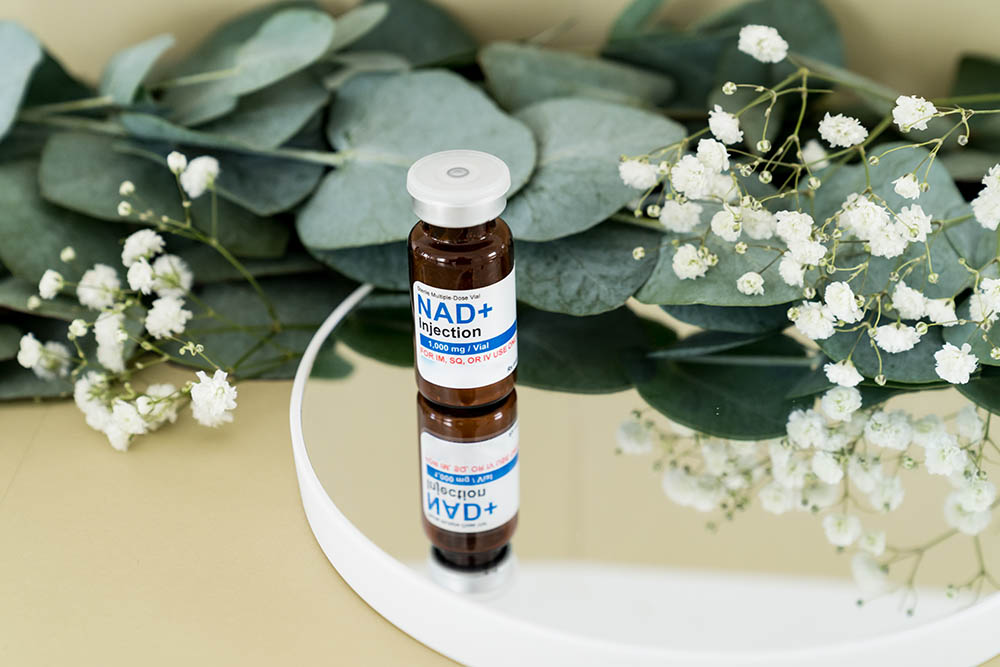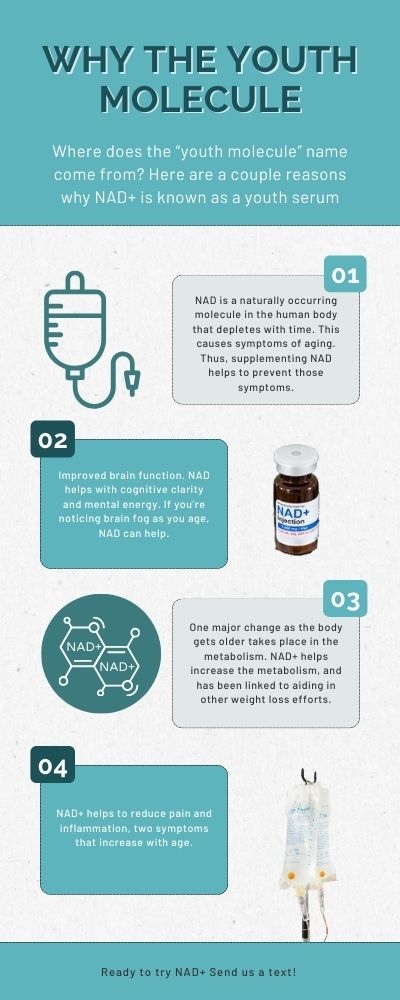In the pursuit of unlocking the secrets to prolonged youth and vitality, one molecule has taken center stage in the realm of anti-aging research—NAD+ (nicotinamide adenine dinucleotide). This molecule is often referred to as the “fountain of youth”. NAD+ plays a pivotal role in numerous cellular processes intricately linked with symptoms of aging. In this article, we’ll delve into the multifaceted aspects of the NAD youth molecule, exploring its influence on mitochondrial function, DNA repair, sirtuin activation, cellular communication, and metabolic regulation. As we unravel the science behind this so-called “youth molecule,” we uncover its potential to reverse the effects of aging and enhance various facets of physical well-being. Are you ready to unlock the secrets of the fountain of youth? Let’s get started.

NAD+ (nicotinamide adenine dinucleotide) is often referred to as the “fountain of youth” due to its crucial role in various cellular processes that are associated with aging. Here are some key reasons why NAD+ is given this moniker:
Mitochondrial Function: NAD+ is essential for the proper functioning of mitochondria, the energy-producing organelles in cells. As we age, mitochondrial function tends to decline, leading to decreased energy production. By supporting mitochondrial health, NAD+ is believed to contribute to increased cellular energy, potentially slowing down the aging process.
DNA Repair: NAD+ is involved in DNA repair processes. As cells age, DNA damage accumulates, contributing to the aging of tissues and organs. NAD+ is thought to play a role in maintaining the integrity of the DNA and promoting more efficient repair mechanisms.
Sirtuin Activation: NAD+ is a co-factor for sirtuins (more to come later), a class of proteins that regulate various cellular functions, including gene expression, DNA repair, and cell survival. Activation of sirtuins has been linked to increased lifespan and improved healthspan. Aging is accelerated by inactive sirtuins, something NAD can fix!
Cellular Communication: NAD+ is involved in cellular signaling pathways, influencing processes like inflammation and stress response. Cellular health is heavily impacted by lower NAD+ levels.
Metabolic Regulation: NAD+ plays a crucial role in metabolic processes, including the regulation of glucose and lipid metabolism. By influencing these pathways, NAD+ may contribute to maintaining metabolic health and potentially preventing age-related metabolic disorders.
Let’s get into the specifics behind the NAD youth molecule and what age-reversing effects an individual who uses it can experience. If you’re interested in what the NAD treatment is like, read more here. The biggest thing that NAD supplementation can do is reverse the effects of low NAD levels, something that naturally occurs as people age. According to Jill Carnahan, two of the top drivers of aging are mitochondrial dysfunction and genomic instability.
Mitochondrial dysfunction occurs when mitochondria in cells gets older. It begins to run less efficiently and can even become toxic. This is a huge driver in cellular aging and turnover. Sirtuins are a cellular enzyme that directly contribute to genomic stability. When these enzymes are inactive, genomic instability is more rampant and contributes to signs of aging. Studies have found that when Sirtuins are inactive, it is due to low NAD. So not only does low NAD speed up aging, it contributes to additional negative effects. Here is how supplementing NAD can combat these effects:
Improved brain function: Without enough NAD youth molecule, the mitochondria in the brain become dysfunctional and can lead to neurodegenerative conditions. This can be aided by taking NAD supplements to prevent mitochondrial dysfunction.
Improved Cardiovascular Conditions: The cardiovascular system also relies on mitochondria as well as Sirtuins to maintain a healthy system. NAD can be used to combat dysfunction and depletion, leading to improved cardiovascular health.
Increased Energy: NAD fights fatigue
Decreased Cellular Antioxidants: SIRT3 shields cells from reactive oxygen species (ROS) Basically, when there is not enough SIRT3 to act as an antioxidant, cells can become unhealthy and damaged.
Increased Fatigue: Chronic fatigue syndrome (CFS) and fibromyalgia usually include symptoms like “brain fog” and joint pain. The NAD youth molecule can help reverse this. Low ATP levels in patients with CFS and fibromyalgia suggest that replenishing NAD+ could stimulate ATP generation, increasing energy levels.

NAD+ can assist with combatting symptoms of aging and can lead to improved strength, cognitive clarity, and energy.
The NAD youth molecule offers a range of potential benefits, including support for mitochondrial function, DNA repair, sirtuin activation, cellular communication, and metabolic regulation. These benefits may contribute to improved energy levels, enhanced cellular health, and potentially slowing down certain aging processes.
The timeframe for NAD+ to start working can vary among individuals. Some users report experiencing benefits like increased energy relatively quickly, while longer-term effects on aging-related processes may require sustained use.
There is no direct evidence to suggest that NAD+ causes weight gain. In fact, NAD+ is often associated with metabolic regulation, and some studies suggest it may contribute to maintaining metabolic health.
Is NAD+ The Fountain of Youth?
https://www.ncbi.nlm.nih.gov/pmc/articles/PMC3405151/
https://www.ncbi.nlm.nih.gov/pmc/articles/PMC7238909/